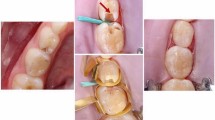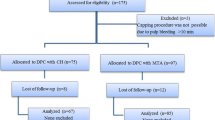Abstract
Purpose
This study aimed at the following: (a) To evaluate the effectiveness of direct pulp capping (DPC) in children’s primary molars using a combination of three antibiotics (3Mix-MP) as direct pulp capping materials compared with Calcium Hydroxide and (b) to assess the impact of pulp exposure diameter, its location and restoration extent on the success rate of the technique.
Methods
This was a randomized double-blind, parallel, two-arm controlled trial. Forty-four primary molars with deep active caries, whose removal resulted in pulp exposures, were treated with direct pulp capping and were allocated randomly into two groups: Group A, DPC with 3Mix-MP; and group B, DPC with Calcium Hydroxide (CH). All teeth were restored with composite resin restorations. The exposures were classified according to their diameter, location and number of the filling surfaces. Clinical follow-ups were performed at intervals of 3 months for 1 year, and radiographical follow-ups were done after 6–12 months. Data were assessed using Chi-squared test (χ2) at a 0.05 level of significance and binary logistic regression was performed to determine the effect of the characteristics of the carious lesion on success rates.
Results
The success rate of the technique was 54.5% in group A and 77.3% in group B, but the difference was not statistically significant. The pulp exposure diameter, its location and the number of the filling surfaces did not affect the success rate significantly.
Conclusion
(a) Direct pulp capping in primary teeth achieved comparable success rates with no significant difference between 3Mix-MP and Calcium hydroxide. (b) The exposure location, its diameter and the extent of the restoration had no significant impact on the success rates of direct pulp capping in primary teeth.
Trial registration
ISRCTN, ISRCTN13525994. Registered 31 October 2018 – Retrospectively registered, (http:// www.isrctn.com/ISRCTN13525994).



Similar content being viewed by others
Data availability
The datasets used and/or analysed during the current study available from the corresponding author on reasonable request.
References
Bergenholtz G. Advances since the paper by Zander and Glass (1949) on the pursuit of healing methods for pulpal exposures: historical perspectives. Oral Surg Oral Med Oral Pathol Oral Radiol Endodontology. 2005;100(2):S102–8.
Chisini LA, Collares K, Cademartori MG, de Oliveira LJC, Conde MCM, Demarco FF, et al. Restorations in primary teeth: a systematic review on survival and reasons for failures. Int J Paediatr Dent. 2018;28(2):123–39.
Coll JA, Seale NS, Vargas K, Marghalani AA, Al Shamali S, Graham L. Primary tooth vital pulp therapy: a systematic review and meta-analysis. Pediatr Dent. 2017;39(1):16–123.
Cooper PR, Holder MJ, Smith AJ. Inflammation and regeneration in the dentin-pulp complex: a double-edged sword. J Endod. 2014;40(4 Suppl):S46-51.
Cox CF, Sübay RK, Ostro E, Suzuki S, Suzuki SH. Tunnel defects in dentin bridges: their formation following direct pulp capping. Oper Dent. 1996;21(1):4–11.
Cvek M, Granath L, Cleaton-Jones P, Austin J. Hard tissue barrier formation in pulpotomized monkey teeth capped with cyanoacrylate or calcium hydroxide for 10 and 60 minutes. J Dent Res. 1987;66(6):1166–74.
Demir T, Cehreli ZC. Clinical and radiographic evaluation of adhesive pulp capping in primary molars following hemostasis with 1.25% sodium hypochlorite: 2-year results. Am J Dent. 2007;20(3):182–8.
Dhar V, Marghalani AA, Crystal YO, Kumar A, Ritwik P, Tulunoglu O, et al. Use of vital pulp therapies in primary teeth with deep caries lesions. Pediatr Dent. 2017;39(5):146–59.
Fallahinejad Ghajari M, Asgharian Jeddi T, Iri S, Asgary S. Direct pulp-capping with calcium enriched mixture in primary molar teeth: a randomized clinical trial. Iran Endod J. 2010;5(1):27–30.
Garrocho-Rangel A, Flores H, Silva-Herzog D, Hernandez-Sierra F, Mandeville P, Pozos-Guillen AJ. Efficacy of EMD versus calcium hydroxide in direct pulp capping of primary molars: a randomized controlled clinical trial. Oral Surg Oral Med Oral Pathol Oral Radiol Endod. 2009;107(5):733–8.
Goldberg M, Njeh A, Uzunoglu E. Is pulp inflammation a prerequisite for pulp healing and regeneration? Mediators Inflamm. 2015;2015:347649.
Handajani J, Haniastuti T, Ohshima H, Hoshino E, Mada G. Survival of root canal pulp tissue after pulpitis. J LSTR Ther. 2010;9:1–6.
Kalnins V, Frisbie HE. The effect of dentine fragments on the healing of the exposed pulp. Arch Oral Biol. 1960;2:96–103.
Kanaya S, Xiao B, Sakisaka Y, Suto M, Maruyama K, Saito M, et al. Extracellular calcium increases fibroblast growth factor 2 gene expression via extracellular signal-regulated kinase 1/2 and protein kinase A signaling in mouse dental papilla cells. J Appl Oral Sci. 2018;26:e20170231.
Kassa D, Day P, High A, Duggal M. Histological comparison of pulpal inflammation in primary teeth with occlusal or proximal caries. Int J Paediatr Dent. 2009;19(1):26–33.
Kotsanos N, Arapostathis KN, Arhakis A, Menexes G. Direct pulp capping of carious primary molars. A specialty practice based study. J Clin Pediatr Dent. 2014;38(4):307–12.
Matsuo T, Nakanishi T, Shimizu H, Ebisu S. A clinical study of direct pulp capping applied to carious-exposed pulps. J Endod. 1996;22(10):551–6.
Mizuno M, Banzai Y. Calcium ion release from calcium hydroxide stimulated fibronectin gene expression in dental pulp cells and the differentiation of dental pulp cells to mineralized tissue forming cells by fibronectin. Int Endod J. 2008;41(11):933–8.
Monteiro J, Day P, Duggal M, Morgan C, Rodd H. Pulpal status of human primary teeth with physiological root resorption. Int J Paediatr Dent. 2009;19(1):16–25.
Morotomi T, Washio A, Kitamura C. Current and future options for dental pulp therapy. Jpn Dent Sci Rev. 2019;55(1):5–11.
Mutluay M, Arıkan V, Sarı S, Kısa Ü. Does achievement of hemostasis after pulp exposure provide an accurate assessment of pulp inflammation? Pediatr Dent. 2018;40(1):37–42.
Nowak A, Christensen JR, Mabry TR, Townsend JA, Wells MH. Pediatric Dentistry-E-Book: Infancy through Adolescence. Elsevier Health Sciences, © Saunders, USA. 2018.
Nugroho R, Budi AT, Kunarti S. The application of lesion sterilization and tissue repair 3Mix-MP for treating rat’s dental pulp tissue. Dent J Maj Kedokt Gigi. 2015;48(1):12–5.
Ortiz-Ruiz AJ, Pérez-Guzmán N, Rubio-Aparicio M, Sánchez-Meca J. Success rate of proximal tooth-coloured direct restorations in primary teeth at 24 months: a meta-analysis. Sci Rep. 2020;10(1):6409.
Parisay I, Ghoddusi J, Forghani M. A review on vital pulp therapy in primary teeth. Iran Endod J. 2015;10(1):6–15.
Peacock J, Peacock P. Oxford handbook of medical statistics. Oxford University Press, a department of the University of Oxford, UK. 2011.
Ranganathan P, Pramesh CS, Aggarwal R. Common pitfalls in statistical analysis: intention-to-treat versus per-protocol analysis. Perspect Clin Res. 2016;7(3):144–6.
Ranly DM, Garcia-Godoy F. Current and potential pulp therapies for primary and young permanent teeth. J Dent. 2000;28(3):153–61.
Rashid F, Shiba H, Mizuno N, Mouri Y, Fujita T, Shinohara H, et al. The effect of extracellular calcium ion on gene expression of bone-related proteins in human pulp cells. J Endod. 2003;29(2):104–7.
Raslan N, Wetzel W-E. Exposed human pulp caused by trauma and/or caries in primary dentition: a histological evaluation. Dent Traumatol Off Publ Int Assoc Dent Traumatol. 2006;22(3):145–53.
Raslan N, Mansour O, Assfoura L. Evaluation of antibiotic mix in non-instrumentation endodontic treatment of necrotic primary molars. Eur J Paediatr Dent. 2017;18(4):285–90.
Ravi GR, Subramanyam RV. Calcium hydroxide-induced resorption of deciduous teeth: a possible explanation. Dent Hypotheses. 2012;3(3):90.
Ricucci D, Siqueira JF, Li Y, Tay FR. Vital pulp therapy: histopathology and histobacteriology-based guidelines to treat teeth with deep caries and pulp exposure. J Dent. 2019;86:41–52.
Sathorn C, Parashos P, Messer H. Antibacterial efficacy of calcium hydroxide intracanal dressing: a systematic review and meta-analysis. Int Endod J. 2007;40(1):2–10.
Schröder U. Effects of calcium hydroxide-containing pulp-capping agents on pulp cell migration, proliferation, and differentiation. J Dent Res. 1985;64(4):541–8.
Smaïl-Faugeron V, Glenny A-M, Courson F, Durieux P, Muller-Bolla M, Fron Chabouis H. Pulp treatment for extensive decay in primary teeth. Cochrane Database Syst Rev. 2018;31(5):003220.
Sujlana A, Pannu PK. Direct pulp capping: a treatment option in primary teeth?? Pediatr Dent J. 2017;27(1):1–7.
Tada H, Nemoto E, Kanaya S, Hamaji N, Sato H, Shimauchi H. Elevated extracellular calcium increases expression of bone morphogenetic protein-2 gene via a calcium channel and ERK pathway in human dental pulp cells. Biochem Biophys Res Commun. 2010;394(4):1093–7.
Takushige T, Cruz EV, Moral MAA, Hoshino E. Non-surgical treatment of pulpitis, including those with history of spontaneous pain, using a combination of antibacterial drugs. J LSTR Ther Int Web Version. 2008;7:1–5.
Tuna D, Olmez A. Clinical long-term evaluation of MTA as a direct pulp capping material in primary teeth. Int Endod J. 2008;41(4):273–8.
Tziafas D. The future role of a molecular approach to pulp-dentinal regeneration. Caries Res. 2004;38(3):314–20.
Acknowledgement
The staff at the Department of Pediatric Dentistry is acknowledged for their assistance.
Funding
The study was funded by Tishreen University, Latakia. Syria (ref: 4075/20-3). The funding body had no role in data handling nor in the writing of this manuscript.
Author information
Authors and Affiliations
Contributions
We declare that all authors have made substantial contributions. NR designed the research study. HA performed the research including patient recruitment and data collection. NR and HA analysed the data. HA prepared the manuscript draft with important intellectual input from NR. NR revised the manuscript. All authors approved the final manuscript. All authors had complete access to the study data. All authors agree to be accountable for all aspects of the work in ensuring that questions related to the accuracy or integrity of any part of the work are appropriately investigated and resolved.
Corresponding author
Ethics declarations
Conflict of interest
The authors declare that they have no competing interests.
Ethical approval
The IRB of Tishreen University had approved the study. Approval No. 3179 was obtained in session (No.18), held on August 2, 2016.
Informed consent to participate
A written consent was secured from the parents prior to submit an image of their child's teeth.
Informed consent for publication
A written consent was secured from the parents prior to submit an image of their child's teeth.
Additional information
Publisher's Note
Springer Nature remains neutral with regard to jurisdictional claims in published maps and institutional affiliations.
Rights and permissions
About this article
Cite this article
Ali, H., Raslan, N. Direct pulp capping (DPC) in primary molars using (3Mix-MP) and the characteristics of the carious lesion as predictor factors for its success: a randomized controlled trial. Eur Arch Paediatr Dent 22, 633–642 (2021). https://doi.org/10.1007/s40368-020-00600-3
Received:
Accepted:
Published:
Issue Date:
DOI: https://doi.org/10.1007/s40368-020-00600-3




